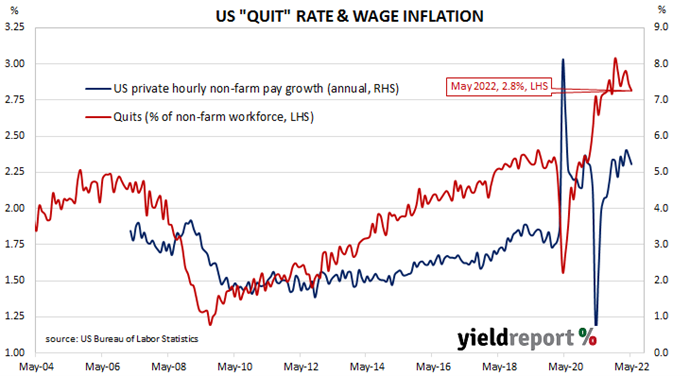Summary: US quit rate unchanged in June; bond yields drop on hawkish Fed statements; expectations of higher rates harden; labour demand easing, not enough to bring wages under control; quits, openings, separations all down.
The number of US employees who quit their jobs as a percentage of total employment increased slowly but steadily after the GFC. It peaked in March 2019 and then tracked sideways until virus containment measures were introduced in March 2020. The quit rate then plummeted as alternative employment opportunities rapidly dried up. Following the easing of US pandemic restrictions, it proceeded to recover back to its pre-pandemic rate in the third quarter of 2020 and trended higher through 2021 before easing in the first half of 2022.
Figures released as part of the most recent Job Openings and Labor Turnover Survey (JOLTS) report show the quit rate remained unchanged in June. 2.8% of the non-farm workforce left their jobs voluntarily, the same percentage as in May, even though there were 37,000 fewer quits and an additional 372,000 people employed.
US Treasury yields jumped on the day, especially at the short end of the curve, as markets took note of hawkish messages from several FOMC members. By the close of business, the 2-year Treasury bond yield had gained 17bps to 3.03%, the 10-year yield had added 18bps to 2.75% while the 30-year yield finished 9bps higher at 3.01%.
In terms of US Fed policy, expectations of higher federal funds rates over the next 12 months hardened. At the close of business, September contracts implied an effective federal funds rate of 2.515%, 19bps higher than the current spot rate while November contracts implied a rate of 3.225%. July 2023 futures contracts implied 3.24%, 91bps above the spot rate.
NAB Director of Economics Tapas Strickland said the figures show “labour demand is easing but perhaps not rapidly enough to bring wages under control as illustrated in last Friday’s Employment Cost Index.”
The fall in total quits was led by 51,000 fewer resignations in the “Construction” sector while the “Federal Government” sector experienced the single largest rise, increasing by 11,000. Overall, the total number of quits for the month fell from May’s revised figure of 4.274 million to 4.237 million.
Total vacancies at the end of June decreased by 605,000, or 5.4%, from May’s revised figure of 11.303 million to 10.698 million. The fall was driven by a 343,000 drop in the “Retail trade” sector while the “Health care and social assistance” sector experienced the single largest increase, rising by 79,000. Overall, 11 out of 18 sectors experienced fewer job openings than in the previous month.
Total separations decreased by 86,000, or1.4%, from May’s revised figure of 6.017 million to 5.931 million. The fall was led by the “Wholesale trade” sector where there were 27,000 fewer separations than in May. Separations declined in 9 out of 18 sectors.
The “quit” rate time series produced by the JOLTS report is a leading indicator of US hourly pay. As wages account for around 55% of a product’s or service’s price in the US, wage inflation and overall inflation rates tend to be closely related. Former Federal Reserve chief and current Treasury Secretary Janet Yellen was known to pay close attention to it.


